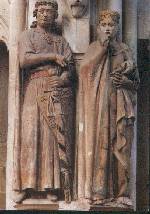-
Uta and Ekkehart

Uta lived in another city a long time ago. By now she has been standing in the nave of the cathedral for seven centuries.
When I was a child, I got a postcard of Uta from Naumberg. I fixed the card to the wall in the hall with a drawing pin so that whenever I went out or came in, I saw Uta's delicate stone features.
Since then, I have seen other pictures of Uta. In one Uta is alone; in another her husband, Ekkehart, stands by her side. Between them, it seems to me, a deep and abiding silence intervenes.
Uta's cloak-wrapped form is proud and reserved. She holds the loose robe closed under her chin so that its collar rises almost in front of her mouth. For that reason I look at Uta's mouth almost furtively. It is like a pain that shames her, or a too inti mate part of the body. It is tender and arrogant, a lovely wound, stubbornly forbidding.
Her right hand, which holds the robe, is invisible beneath it. But all the narrow fingers of the left hand are visible, slightly separated from one another. On her forefinger is a large, round ring, no doubt given her by Ekkehart. She has another jewel, too, in her otherwise simple attire: a buckle attached to the left shoulder of her robe, almost the same as on Ekkehart's broad chest.
Her hair cannot be seen: it is hidden by a helmet-shaped headdress surmounted by a lowish crown.
Her eyes look past you. Her lower lids are slightly narrowed, as if what she sees does not really please her. Quite right: a faint contempt sharpens Uta's gaze, so cloaked in tenderness and refinement that it is hardly recognisable.
Uta and Ekkehart. They are among the founders of the cathedral of Naumberg, aristocrats of their city. The unknown master who sculpted Uta and Ekkehart had never seen them. When their portraits were completed, they had already been lying for decades in the crypt beneath this skyscraper, which was not built according to earthly dimensions.
Everything here is vertical as in a forest. But the glittering roses of the windows rise higher than the crowns of trees. There are no walls; only glass, pillars, ribs - only the fretwork of lath and staff, a thin line rising from octave to octave.
No, this is not a building, but a road raised up, a delirium knitted of stone, the megalomanic dream of a spider.
Little matter, more hope. And the higher the spears of the towers reach, the farther they banish what cannot be seen.
At their roots, in the midst of the strained pillars, a stone among stones, stands Uta. The evasion of her eyes, the collar raised to protect her face, the mouth that has been on the point of trembling for seven hundred years... Perhaps she would like to leave this place, withdraw into the shadows, decay and disintegrate into nothing.
Uta of Naumberg cathedral. Is there another statue which, in its unmoving stone, bears witness so incontrovertibly to the isolation of human flesh and the trembling of the spirit?
Leena Krohn
Translated from the Finnish by Hildi Hawkins
From: Doņa Quixote and Gold of Ophir, Carcanet 1995